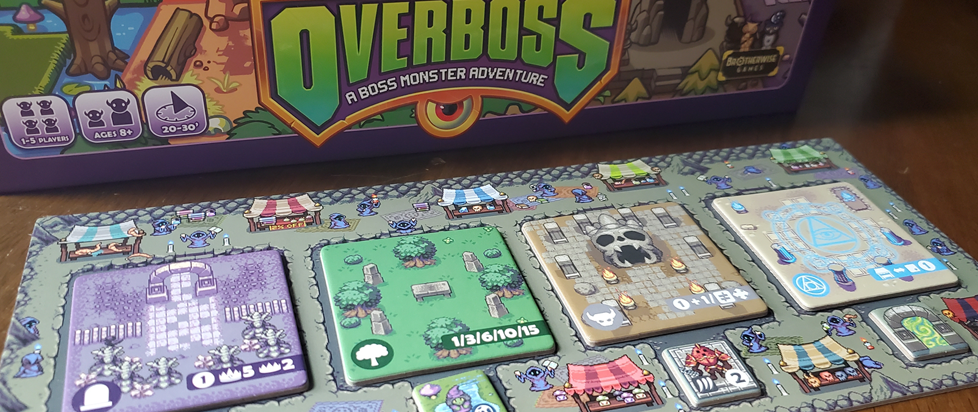
Fearful Symmetry: Building the Best of All Possible Overworlds in Overboss
I see board games in the store and they always look so cool and then I buy them and bring them home, I’m so excited to open them, and then I play them, like, twice… This column is dedicated to the love of games for those of us whose eyes may be bigger than our stomachs when it comes to playing, and the joy that we can all take from games, even if we don’t play them very often.
A long time ago, during a board game party at a friend’s house (remember back when we had things like “friends” and “parties?”) I played a game of Boss Monster and enjoyed it. Honestly, though, it’s been long enough now that I couldn’t tell you for sure whether I actually enjoyed the game or just the cute pixel artwork that accompanied all the cards.
Fast forward to last year, when I backed a new game from the same folks, set in the same world. Originally called Overlord, the title changed to Overboss before all was said and done. As in Boss Monster, you take (at least thematic) control of a, well, boss monster once again. This time, however, instead of creating a dungeon to trap and hopefully slay unwitting adventurers, you’re competing to create the best overworld.
The game plays with a host of top-down overworld tiles, representing various types of terrain, from forests and graveyards to cloud islands and summoning circles. Every round, new tiles and tokens show up in the market for you to pick from. In the games simplest form, you select a tile and the token that was randomly drawn with it, and you place them on your board. Different terrain types score differently, and each monster token has an affinity to a specific type of terrain, scoring more if it’s played on that terrain.
This means that, while the game is competitive, there’s nothing terribly cutthroat about it, at least in its most basic iteration. The success of the Kickstarter allowed the developers to create a number of optional wrinkles that can change the way the game is played – from some of the more complex terrain types to additional rules like boss cards and gambits that you can play against other players. While these can complicate the game and make it more competitive, it’s plenty of fun to play the regular way.
In fact, as of this writing, I have most often played Overboss solo. When playing solo, everything works more or less the same as normal, but you’re only playing against yourself, just trying to wrack up the highest score you can. To keep you on your toes, whenever you draft a tile and token set from the market, one of the others is discarded.
In a world where plenty of board games at least claim to be playable with only one person it is, in my experience, rare to find one that actually plays well in solitaire mode. Overboss is surprisingly fun to play by yourself, with challenges that come from the randomness of the tiles and from trying to shape your own strategy to fit what’s available as it comes along the conveyer belt. There’s an extended “campaign” mode of solo play that I haven’t tried, which encourages you to build overworlds according to certain criteria, but even just playing the basic game provided me with many rounds of enjoyably shuffling and placing tiles.
Overboss is the kind of game that gets described as “simple to learn, impossible to master,” or something to that effect. And that’s probably the case. The “simple to learn” part is certainly true, and a solo game can easily be played in less than twenty minutes. The first time I sat down to play it, I ran through three solo games in one sitting. And that after having only read through the rules once.
I did have to consult them a few times while playing, most often for help recalling the intricacies of scoring – the scoring methods for the different tiles are summarized on them, but the shorthand they use takes a bit of getting used to – but not so frequently that it bogged my playing down.
Solo play negates the possibility of many of the game’s more advanced rules, but the more complex terrain types can absolutely be played solo, continuing to offer a unique challenge, even when there’s no one else around the table.
As with Boss Monster, the art here is all old-school pixel style, designed to emulate the overworlds of top-down adventure RPG video games like Legend of Zelda. There’s a huge and obvious (and welcome) Legend of Zelda influence here, yet the game manages to feel like its own thing, for the most part. Interestingly, Overboss started life as a game about gardening, before the mechanics of that were re-skinned to create a second, different game set in the Boss Monster universe.
I think that’s a significant strength, actually. It would be easy for Overboss to feel like a vestigial extension of an existing game. But because the mechanics of the game came first, and then had the Boss Monster aesthetics skinned on top, you get a game that functions admirably as a game, while also getting to enjoy all the little tiles of swamps and caves and dungeon entrances.
As part of the Kickstarter, you could also get some of the Boss Monster core sets on the cheap, which I did. So, if playing games with more than one or two people is ever a thing again, expect an eventual column on how those hold up to my vague memory of playing them that one time…





